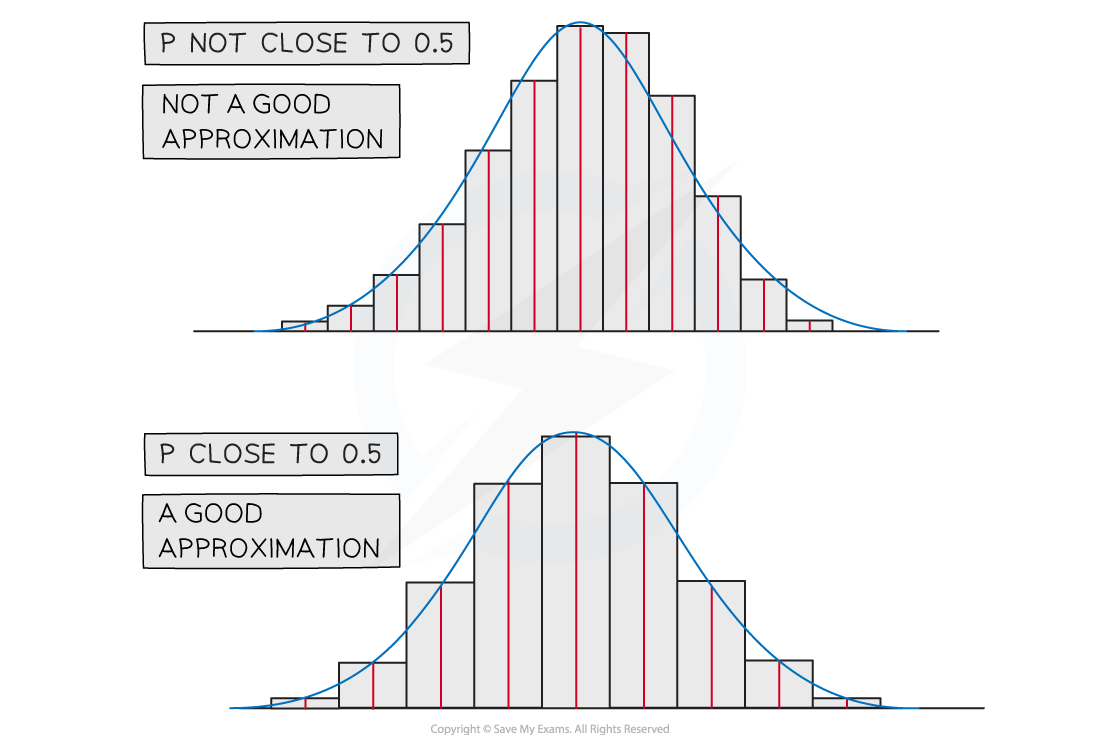Approximating the Binomial Distribution (Edexcel International A Level (IAL) Maths): Revision Note
Exam code: YMA01
Did this video help you?
Normal Approximation of Binomial
When can I use a normal distribution to approximate a binomial distribution?
A binomial distribution
can be approximated by a normal distribution
provided
n is large
p is close to 0.5
The mean and variance of a binomial distribution can be calculated by:

Why do we use approximations?
If there are a large number of values for a binomial distribution there could be a lot of calculations involved and it is inefficient to work with the binomial distribution
These days calculators can calculate binomial probabilities so approximations are no longer necessary
However it is easier to work with a normal distribution
You can calculate the probability of a range of values quickly
You can use the inverse normal distribution function (most calculators don't have an inverse binomial distribution function)
Do I need to use continuity corrections?
Yes!
As the binomial distribution is discrete and normal distribution is continuous you will need to use continuity corrections
How do I approximate a probability?
STEP 1: Find the mean and variance of the approximating distribution
STEP 2: Apply continuity corrections to the inequality
STEP 3: Find the probability of the new corrected inequality
Find the standard normal probability and use the table of the normal distribution
Find the standard normal probability and use the table of the normal distribution
The probability will not be exact as it is an approximate but provided n is large and p is close to 0.5 then it will be a close approximation
Worked Example
The random variable .
Use a suitable approximating distribution to approximate .
Answer:

Did this video help you?
Poisson Approximation of Binomial
When can I use a Poisson distribution to approximate a binomial distribution?
A binomial distribution X~B(n, p)can be approximated by a Poisson distribution
provided
n is large ( typically > 50 )
p is small
The mean of a binomial distribution can be calculated by:
The Poisson distribution is derived from the binomial distribution for conditions where n is becoming infinitely large and p is becoming infinitely small
Do I need to use continuity corrections?
No!
As both the binomial distribution and Poisson distribution are discrete there is no need for continuity corrections
Worked Example
It is known that one person in a thousand who checks a revision website will choose to subscribe. Given that the website received 3000 hits yesterday, use a suitable approximation to find the probability that more than 5 people subscribed.
Answer:

Did this video help you?
Choosing the Approximation
How will I choose which approximation to use?
When deciding what approximating distribution to use first make sure you know the reason why you cannot find the probability using the original distribution
Is the value of n or λ too large?
Will it take too long to carry out the calculations?
Make sure you know what distribution you are approximating from
If your distribution is a binomial distribution, you could either use a Poisson (if p is small) or a normal approximation (if p is close to 0.5)
If your distribution is a Poisson distribution, you will use a normal approximation
Use the conditions for approximations to decide which approximation is appropriate
Calculate the parameters for the approximating distribution

Examiner Tips and Tricks
If you are asked to approximate the binomial distribution but are unsure whether to use Poisson or normal, then calculate the mean and see if it is one of the possible values for λ in the table

Unlock more, it's free!
Did this page help you?